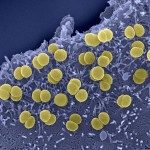Lien vers Pubmed [PMID] – 23123023
Lien DOI – 10.1016/j.vaccine.2012.10.072S0264-410X(12)01532-0
Vaccine 2012 Dec; 31(1): 183-9
Neisseria meningitidis is a human pathogenic bacterium responsible for life threatening and rapidly evolving invasive infections. Several bacterial virulence factors may play primordial roles during host-bacteria interactions. The meningococcal factor H binding protein, fHbp, interacts with the complement negative regulator, factor H (fH), to enhance meningococcal survival. fHbp is a major component in recombinant vaccines against meningococci that are under development. In 2010, we detected variations in fhbp gene during an outbreak provoked by serogroup C isolates belonging to the clonal complex, ST-11. We therefore explored 680 meningococcal isolates (88% of all invasive isolates in 2009 and 2010) by DNA sequencing of fhbp gene. The level of fHbp at the bacterial surface was determined by ELISA and flow cytometry using anti-fHbp antibodies. We also analyzed the interaction of fHbp with human fH as well as the deposition of C3b complement component. We observed important sequence diversity of fHbp in particular within regions known to interact with fH. The distribution of fhbp alleles differed among meningococcal serogroups and clonal complexes. This diversity affected directly binding of fH to fHbp and seemed to influence the deposition of the complement C3b component on the bacterial surface. However, bacterial killing by anti-fHbp antibodies was still achieved and required a minimum level of fHbp at the bacterial surface regardless the binding to fH or sequence diversity. These data have impacts on our understanding of the role of fHbp in meningococcal pathogenesis. They also provide data on the diversity of fhbp before the introduction of vaccines targeting fHbp and stress the need to include characterization of fHbp in typing schemes of meningococcal isolates.

